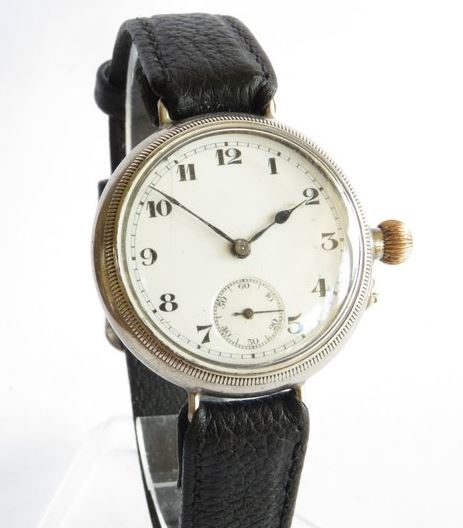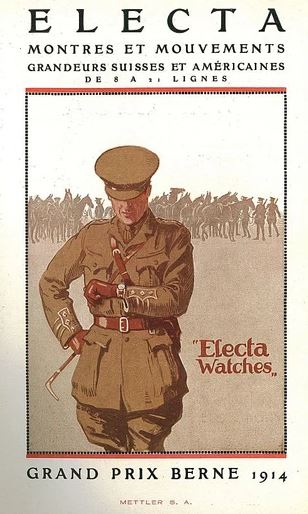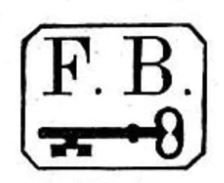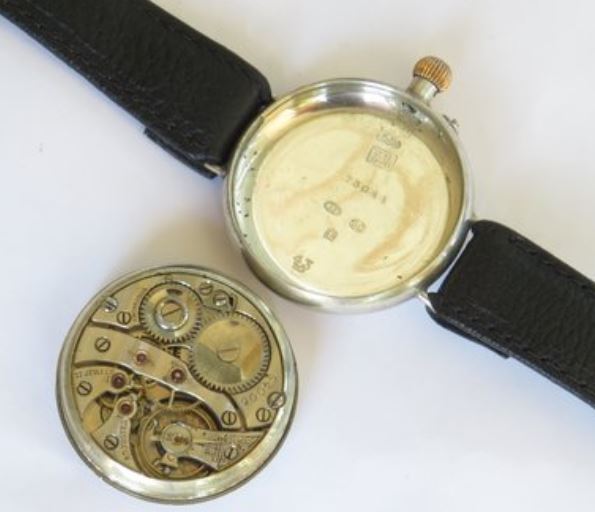Last updated on May 27, 2024
The long search for the elusive Borgel trench watch is finally over. It has taken two years for a suitable watch to become available at one of my preferred suppliers. In this case, this Electa trench watch became available at The Vintage Wrist Watch Company As soon as I saw the watch was available, I called and asked a few simple questions and bought the watch without hesitation. It is in a very presentable condition and keeps good time, so it is a practical timepiece.
Movement
The watch has a Swiss 17-jewel hand-winding movement, identified as made by Electa, which is ticking strongly on my wrist as I type. The movement is branded “Swiss made, 17 Jewels, Adjusted“. A sign of quality is that the jewels are fixed to the movement plate using chatons (screws). In addition, the movement has a split bi-metallic temperature compensated balance and a Breguet overcoil balance spring. It is a pin-set movement. The watch is wound, as expected, by turning the crown. The time is set, by depressing the small pin located near the 4 marker and then turning the crown.
Electa
Gallet & Cie Electa registered the Electa brand in 1906. The brand was used to produce Gallet’s highest quality timepieces, such as this 17-jewel Electa trench watch. Gallet’s history dates all the way back to Humbertus Gallet, a clockmaker who became a citizen of Geneva in 1466. The tradition of clock-making continued through the family line with operations under the name of each of the Gallet family patriarchs. The Gallet & Cie (Gallet & Company) name was officially registered by Julien Gallet (1806–1849) in 1826, when he moved the family business from Geneva to La Chaux-de-Fonds, Switzerland.
In 1912, Gallet started producing their first wristwatches for general distribution, which included a full-sized seconds hand originating from the centre of the dial. This innovation proved useful for timing tasks that emphasized seconds over minutes and hours. When the First World War started in 1914, Gallet was well placed to supply trench watches to front-line troops. They did this under the Electa brand name.
The Electa brand name under Gallet had a relatively short history. The brand suffered from financial difficulties and went into liquidation in 1912. However, the First World War started before the business could be closed down and the demand for trench watches kept the company afloat until the 1920s. Ultimately, the business came to an end in 1926 and Rotherham & Sons bought the Electa factory in La Chaux-de-Fonds. David Boettcher’s excellent website, Vintage Watchstraps, has a detailed history of the Electa brand.
Case
The watch measures 35mm in diameter excluding the winding crown and the fixed wire lugs. The case is silver and there are British hallmarks inside the case back for London (import mark), 1914, and an importer’s mark for Arthur George Rendell. The case is in near-mint condition.
In 1907, the Imported Watch Cases bill came into force, which meant that all imported watches had to be assayed in a UK assay office and marked with British import hallmarks. For this, a sponsor’s mark was required. In this particular case, the sponsor was Arthur George Rendell. He was an employee of Robert Pringle & Sons and was probably in charge, of the department that handled imported watches. At the time, Pringles was the UK’s largest wholesaler of jewellery, silverware, clocks and watches.
Borgel case
The inside of the case back also has the mark for François Borgel. He was a very successful inventor and businessman, and his company became one of the most important watchcase manufacturers of its time. He advertised his screw watch case, such as this example, as “imperméable”, which means that he considered it to be waterproof. Early adopters of the Borgel screw case included Longines and IWC. François Borgel’s died in 1912 and the business was taken over by his daughter Louisa. The business was sold in 1924 to Taubert & Fils who carried it on until the 1970’s supplying many watch manufacturers including Patek Philippe and Vacheron Constantin.
Design
François Borgel first patented his design for a watch case in 1891. It was an early attempt to make watches resistant to dust and moisture. The case back and middle parts are in one piece and threaded internally. The movement, complete with dial and hands, is mounted in a carrier ring. This then screws down into the threaded case back. To unscrew the movement from a Borgel screw case you first pull the crown outwards and hold it. This disengages the piece of the stem that is attached to the crown from the movement and keeps it clear whilst it is being unscrewed from the case. You then turn the milled bezel anticlockwise and the movement unscrews out of the case.
Inserting the movement back into the case is the exact reverse of this process. The threads in the case and on the carrier ring are very fine so it is important to be careful to avoid getting them cross-threaded. If everything is lined up correctly the movement should screw back into the case easily. When the movement is nearly completely screwed in and the 12 on the dial is approaching the correct position, release the crown and continue turning the bezel. The winding stem will lock into place and the movement will stop turning. Note, this does take multiple attempts and a considerable amount of patience.
Watch face
The acrylic crystal has a light scratch but it is difficult to see with the naked eye. The enamel dial has blued steel hands, a subsidiary seconds dial and outer minute markers. There is a short scratch by number 2 and a couple of faint hairline cracks. These markings are only visible under magnification and in no way detract from the appearance of the dial.
Condition
The case is in exceptional condition for a timepiece that is over a hundred years old. It passed the 24-hour timekeeping test, running 1 minute fast. This is perfectly acceptable for an antique watch. The power reserve is a very respectable 30 hours. I have really enjoyed wearing this antique watch over the past week and I am sure I will continue to do so for a long time to come. Now that the search for the Borgel trench watch is over, I am going to have to find myself another Holy Grail.
Related content
The Borgel Watch Case Company of Geneva at Vintage Watchstraps.



